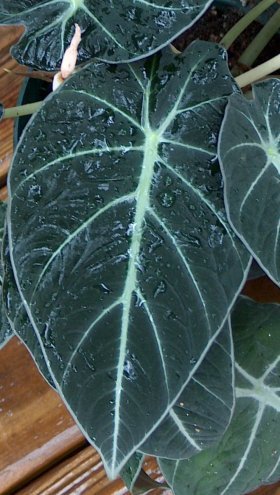





Of all the smaller Jewels, Alocasia reginula 'Black Velvet' is one of the most familiar and recognizable. The dark, almost black leaves, adorned with brilliant silvery-white veins and velvety look make for an unmistakably beautiful sight. You just want to hug and baby this wonderful little plant, but in so doing you may kill her with kindness. Read on. . .
Alocasia reginula is, literally, the Little Queen Alocasia. One look at the plant and you know why. Pictures really do not do this plant justice because when you are face to face with a specimen, you just want to marvel at it and touch it softly. The leaves have a regal velvety look, and they feel somewhat velvety, but with an added ripply texture, as though the leaf veins were embossed. With silvery-white main veins that have a hint of sparkle to them, you know this Little Queen is in full royal regalia. As you study the plant more closely, you find additional little surprises, from the reddish patches on the undersides of the leaves, to the pale cast of the petioles and the small occasional spots on them. You'll notice that the leaves are unexpectedly thick in substance, almost succulent. Everything about this plant screams, "Love Me, Baby Me, Care for Me!", until you try to do just that.
You went out of your way, waiting hand and foot on your Little Queen. You've been treating her like the tropical rainforest monarch that she is, right? So how could she be on her death bed and inconsolable after just a few weeks, or even days? The fact is, her very nature showed in no uncertain terms what she needed and failed to get. How did that happen? Well, remember what I told you about the leaves? They are unusually thick for an Alocasia, almost succulent. This is a powerful clue to what ails your Little Queen. She cannot tolerate wet soil, and even soil that is moist all the time is going to make her ill. First and foremost, she needs air, and by that I mean air to the roots: soil aeration.  To provide this, the soil media mix must be very well draining, preferably with a minimum of peat moss and plenty of washed perlite, composted pine bark, and silica sand. Secondly, to keep fresh air in the root zone, she needs to be watered deeply but infrequently. Deeply means such that the water percolates down and drains quickly out of the pot, drawing fresh air into the soil pores as it exits. Infrequently means so the roots of your Little Queen don't stay too wet between waterings.
To provide this, the soil media mix must be very well draining, preferably with a minimum of peat moss and plenty of washed perlite, composted pine bark, and silica sand. Secondly, to keep fresh air in the root zone, she needs to be watered deeply but infrequently. Deeply means such that the water percolates down and drains quickly out of the pot, drawing fresh air into the soil pores as it exits. Infrequently means so the roots of your Little Queen don't stay too wet between waterings.
You might be thinking that your Little Queen is a finicky one, and you are right! Royalty is entitled to it. She wants to be kept warm, but not too humid, in bright light, but not full sun, and cozy, but not too much root room. I had a really nice Little Queen and, to accommodate her growth and her need for aerated soil, I planted her up from a 6" pot to a 2.9 gallon Air-Pot, the ultimate in root aeration aids. For a while she did well, but what I had overlooked led to her demise. Too great a soil mass will retain water even if you water infrequently because the root system on these plants is not very extensive. The unused portion of soil mass will become wetter gradually and will end up keeping the Queen's portion too moist as well. Sadly, by the time I figured this out, my Little Queen was ready for her obituary.
Everything I've shared here is actually the story of my own heartbreaking experiences with Little Queens. I have learned the hard way what they require in order to last for more than a few weeks. In fact, I have one now that I've been growing for over a year. She's not very large, but she's still alive and looks well. That's progress because the first one I ever had, I lost after just a few weeks.
So you need to give them very well draining soil media, let them dry out between deep waterings, give them bright light but not sun, and fertilize lightly, or not at all if the weather is cool and your Queen is not growing much.
Is there anything else you can do to please Her Royal Majesty? Yes, there is, and it involves giving her an entourage of sorts, a small community of friendly microbes to help protect her from the ever-present interlopers that are anxious to dethrone her. Consider enlisting the T-22, using RootShield, and bring in some endomycorrhizae to assist as well. Other products that can help are Plant Growth Activator and Companion, whose active microbes will be featured in future articles.
Armed with the knowledge I've shared here, you should be able to grow a Little Queen of your own to adore, enjoy and serve. She'll eventually want a little companionship, though, and like proper royalty, that means giving her (and yourself) some new Jewels. Watch for upcoming articles featuring them.
Photo credit: LariAnn Garner, Aroidia Research
Copyright © www.100flowers.win Botanic Garden All Rights Reserved